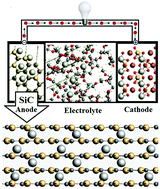Layered silicon carbide: a novel anode material for lithium ion batteries
Abstract
The structural stability of carbon and the high theoretical capacity of silicon was the motivation for investigating the prospects of layered silicon carbide (SiC). The density functional theory (DFT) based computations and first-principles molecular dynamics (MD) simulations were performed to determine the likelihood of being able to use 2D SiC layers as a lithium intercalation compound. The calculations were performed using dispersion corrected exchange correlation and this revealed the stability of the layers, and the transfer of charge from Li to the host during intercalation was at a maximum storage capacity of 699 mA h g−1. The layers offered better flexibility, a higher rate capability and a three times larger capacity when compared to graphite bilayers. The diffusion barrier calculated here, with a small energy barrier of 0.40 eV, illustrated a good rate capability. The findings and comparison with graphite revealed that layered SiC is an appropriate anode material for used in lithium ion batteries (LIBs) because of its structural firmness, high electronic conductivity, low diffusion barrier and high storage capacity.



 Please wait while we load your content...
Please wait while we load your content...